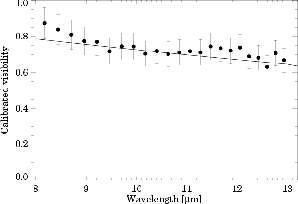


Next: Thibaut Paumard, Frank Eisenhauer,
Up: Session 3: Infrared Interferometry
Previous: Olivier Absil, Emmanuel di
Péter Ábrahám, László Mosoni, Thomas Henning, Ágnes Kóspál,
Christoph Leinert, Attila Moór, Sascha P. Quanz, and Thorsten Ratzka
LOOKING INTO THE HEART OF THE OUTBURSTING STAR V1647 ORI:
FIRST AU-SCALE OBSERVATIONS WITH VLTI/MIDI
LOOKING INTO THE HEART OF THE OUTBURSTING STAR V1647 ORI:
FIRST AU-SCALE OBSERVATIONS WITH VLTI/MIDI
Péter Ábrahám(1), László Mosoni(1), Thomas Henning(2), Ágnes Kóspál(1),
Christoph Leinert(2), Attila Moór(1), Sascha P. Quanz(2), and Thorsten Ratzka(2)
(1) Konkoly Observatory of the Hungarian Academy of Sciences, P.O. Box 67, H-1525 Budapest, Hungary
(2) Max-Planck-Institut für Astronomie, Königstuhl 17, 69117 Heidelberg, Germany
The young eruptive star V1647 Ori was observed with MIDI, the
mid-infrared interferometric instrument at the Very Large Telescope
Interferometer, on March 2, 2005. We present the first spectrally
resolved interferometric visibility points for this object. Our results
are summarised in the following.
- The
calibrated visibilities (see figure) show that the source is resolved
by MIDI on the UT3-UT4 baseline. The visibility curve suggests a
non-uniform temperature distribution of the emitting material. The size
of the mid-infrared emitting region is
 7 AU at 10
7 AU at 10  m.
m.
- The
 m spectrum i) exhibit no obvious spectral
features thus cannot support models consisting of optically thin
components; ii) the source faded in the N-band significantly
(compared to Andrews et al. 2004 ApJ 610, 45); iii) the
correlated flux density, i.e. the emission of the innermost part of the
circumstellar structure, contains
m spectrum i) exhibit no obvious spectral
features thus cannot support models consisting of optically thin
components; ii) the source faded in the N-band significantly
(compared to Andrews et al. 2004 ApJ 610, 45); iii) the
correlated flux density, i.e. the emission of the innermost part of the
circumstellar structure, contains  % of the total
mid-infrared flux density.
% of the total
mid-infrared flux density.
- There are proposals in the
literature that the FU Ori phenomenon is triggered by a close companion
(e.g. Reipurth & Aspin 2004, ApJ 608, 65). A companion would cause
sinusoidal variations in the spectrally resolved visibilities with
appropriate baseline position angles. The shape of our visibility curve
suggests that no companion is present at the measured position angle
whose separation is less than 100 AU and brightness ratio is greater
than 10%. Nor do the acquisition images show any companion. However,
we can exclude the companion only along the measured baseline further
observations will be needed to clarify the existence of a companion.
- A simple disk model is able to fit both the spectral energy
distribution and the observed visibility values simultaneously (solid
line in figure). Model parameters for the disk were the following:
 and
and
 , inner and outer
disk radii
, inner and outer
disk radii  and
and
 , respectively, surface
density
, respectively, surface
density
 , disk mass
, disk mass
 , inclination angle 60^.
, inclination angle 60^.




Next: Thibaut Paumard, Frank Eisenhauer,
Up: Session 3: Infrared Interferometry
Previous: Olivier Absil, Emmanuel di
LESIA, Observatoire de Paris
2006-03-16
